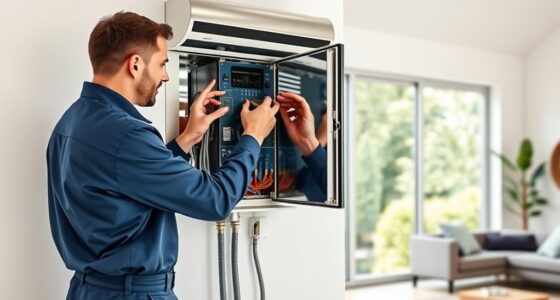To improve visibility, use high bay LED fixtures that provide bright, uniform light over large areas, reducing shadows and glare. Incorporate smart controls like motion sensors and zone-specific lighting to enhance safety and save energy. Maximize natural light with skylights or windows, and use reflective surfaces to improve light distribution. Embracing emerging tech such as adaptive and wireless lighting systems can further optimize brightness and efficiency. Keep exploring for more ways to achieve better visibility and safety.
Key Takeaways
- Use high bay LED fixtures with high lumen output for uniform, bright illumination over large warehouse areas.
- Incorporate smart controls like motion sensors and dimming to optimize lighting based on occupancy and ambient light.
- Maximize natural light through windows, skylights, and reflective surfaces to reduce reliance on artificial lighting.
- Implement zone-specific lighting with adjustable fixtures to enhance visibility in different warehouse areas.
- Follow industry standards like EN 12464 and LEED to ensure safety, energy efficiency, and optimal visibility.
Overview of Warehouse Lighting Challenges
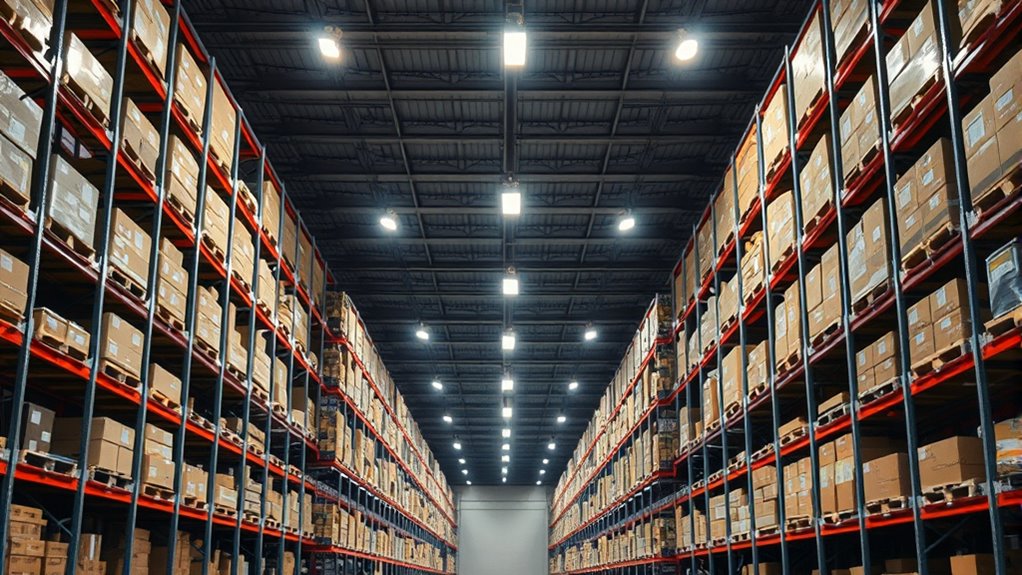
Warehouse lighting presents unique challenges because it must guarantee consistent, bright illumination over vast areas while minimizing maintenance needs. Achieving this requires effective lighting design that provides uniform illumination, preventing glare and shadows that can compromise safety and accuracy. Security considerations also play a role, as well-lit environments help deter theft and unauthorized access. High bay LED fixtures are ideal for these spaces, offering high lumen output and long-lasting performance, often exceeding 50,000 hours of operation. Additionally, energy-efficient lighting solutions help reduce operational costs and environmental impact. Incorporating smart lighting controls can optimize energy use and adapt lighting levels based on activity, further enhancing efficiency. Modern lighting technology advances enable precise control and customization for different warehouse zones. Cold storage warehouses add complexity, requiring lighting systems that perform well in low temperatures without losing efficiency. Proper zoning and control are essential to balance safety, productivity, and energy consumption, especially in areas with varying activity levels. Implementing innovative lighting solutions can help address these challenges effectively. Addressing these lighting challenges ensures a well-lit environment, enhancing safety and operational efficiency across the entire warehouse.
High Bay LED Lighting for Optimal Brightness
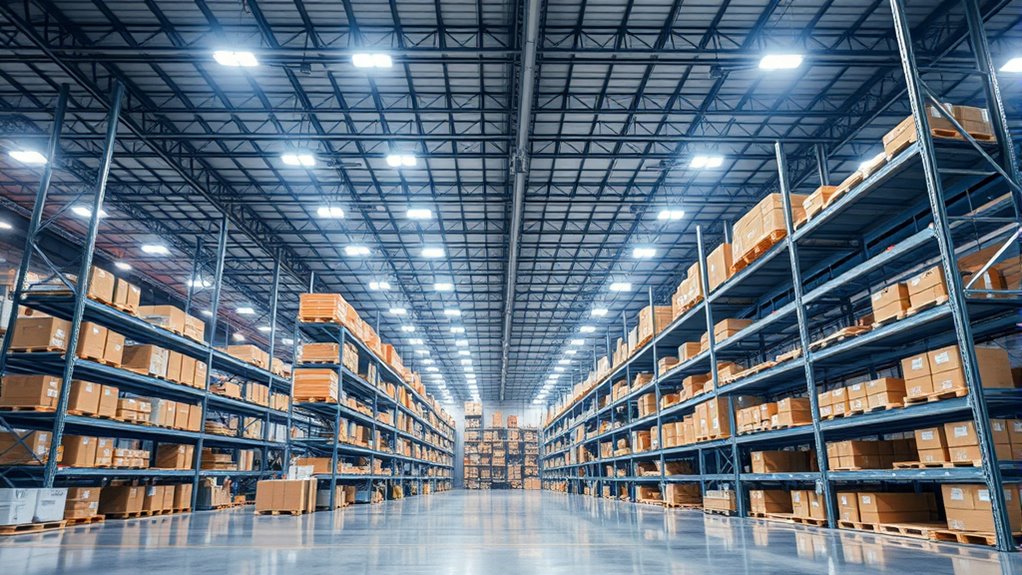
High Bay LED lighting offers a powerful solution for achieving uniform, high-intensity illumination in spaces with ceilings over 20 feet. With high bay LED fixtures, you can deliver lumen outputs from 10,000 to over 50,000 lumens, ensuring ideal brightness across large areas. These lighting solutions not only provide exceptional brightness but also markedly cut energy consumption—up to 80% less than traditional HID or fluorescent high bays. Their long lifespan, exceeding 50,000 hours, reduces maintenance costs and downtime, keeping your operation running smoothly. Advanced models with integrated motion sensors and dimming enhance energy efficiency and safety. Additionally, high bay LED lights perform effectively in cold environments, maintaining consistent brightness and color rendering essential for accuracy and productivity. Energy efficiency features further optimize operational costs by reducing overall power usage.
Smart Motion-Activated Lighting Systems

Have you considered how smart motion-activated lighting systems can enhance energy efficiency and safety in large spaces? These systems use motion sensors like PIR, ultrasonic, or microwave to detect movement and ambient conditions in real time.
When motion is sensed, they automatically turn on or adjust brightness, ensuring lighting is only active when needed. Integration with daylight sensors allows the lights to dim or turn off during sufficient natural light, further boosting energy efficiency.
You can also customize schedules and zones for different areas, optimizing lighting control based on operational needs. Plus, remote monitoring through centralized platforms offers insights into usage patterns and maintenance alerts.
With these features, your space becomes safer, more efficient, and easier to manage.
Task Lighting for Critical Work Areas

Proper task lighting guarantees you see details clearly and reduces mistakes in critical work areas. Using adjustable LED fixtures or portable lamps lets you customize illumination for different tasks. When designed well, this focused lighting boosts accuracy and efficiency while saving energy. Additionally, GMC tuning can optimize the vehicle’s lighting systems for better visibility and safety during night driving. Consulting Entertainment and Parks resources can also help you plan lighting for outdoor leisure spaces effectively. To improve overall image quality in home environments, considering contrast ratio adjustments can significantly enhance visual clarity and depth. Incorporating high-pressure application techniques from airless paint spraying can also ensure more precise and thorough illumination of work surfaces, reducing the need for rework. Implementing proper light distribution techniques can further optimize the effectiveness of your task lighting setup.
Focused Illumination for Tasks
Why is focused illumination essential in critical work areas? Because it directly impacts visibility and accuracy during detailed tasks. Task lighting with LED fixtures provides targeted illumination, ensuring your workspace is well-lit without excess glare or shadows.
Adjustable lighting options, like articulating arm lamps and under-shelf LED panels, let you customize angles and brightness to suit specific tasks. This tailored illumination reduces errors, enhances safety, and boosts productivity—studies show a 20% improvement in accuracy at visual workstations.
Zone-specific task lighting also helps conserve energy by illuminating only necessary areas. By choosing the right lighting options, you create a focused environment that promotes precision, safety, and efficiency in critical work areas.
Adjustable Lighting Solutions
Adjustable lighting solutions are essential in critical work areas because they allow you to tailor illumination precisely to your tasks, enhancing visibility and reducing errors. With adjustable lighting, you can optimize task lighting by positioning articulating arm lamps or portable task lights to suit specific visual needs. Under-shelf LED panels and strips provide uniform, glare-free light in key zones like packing stations and QA areas, supporting accuracy. Proper lighting layout ensures consistent brightness, minimizing shadows that can cause eye strain during detailed work. Dimmable, responsive task lights with motion sensors help you conserve energy while maintaining ideal illumination levels. Additionally, understanding lighting regulations and standards ensures your workspace remains compliant and safe. Incorporating proper light placement is also critical to avoid overly bright or dim spots that can cause fatigue. Considering the best lighting options for your environment can further enhance efficiency and comfort. These adjustable lighting options empower you to create a safer, more efficient workspace that adapts to your needs and improves overall productivity. Furthermore, implementing energy-efficient fixtures can significantly reduce operational costs and promote sustainability in your workspace. As technology advances, integrating automation in lighting can further optimize energy use and user comfort.
Incorporating Natural Light and Reflective Surfaces

Incorporating natural light and reflective surfaces can transform your workspace into a brighter, more energy-efficient environment. By maximizing daylight through strategically placed windows, skylights, and translucent panels, you reduce reliance on artificial lighting and cut energy costs.
Reflective surfaces like glossy floors, light-colored walls, and reflective safety markings boost light distribution and overall illumination, creating a more inviting space. Installing clerestory windows and solar tubes directs natural light deeper into your interior, enhancing brightness and worker comfort.
Using transparent or diffusing panels allows sunlight to penetrate effectively while minimizing glare. These natural and reflective lighting strategies can increase energy efficiency by up to 30%, making your workspace not only brighter but also more sustainable and visually comfortable. Incorporating light reflection techniques can further optimize the distribution of natural light throughout the area, especially when combined with energy-efficient lighting systems.
Zone-Specific and Adjustable Lighting Strategies
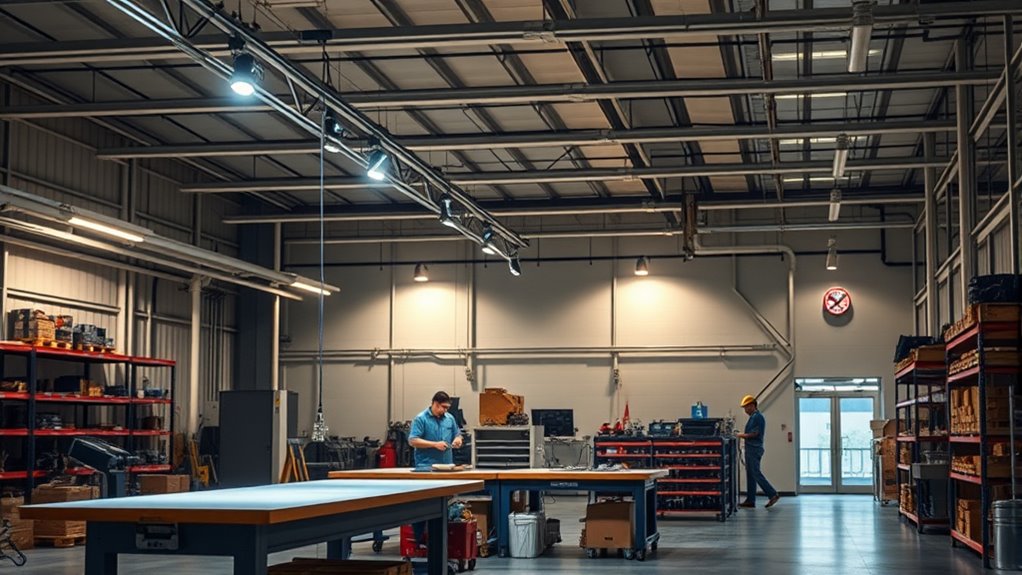
Optimizing lighting within different zones of your workspace enhances both efficiency and safety. Zone-specific lighting allows you to tailor illumination levels—up to 1000 lux in pick zones and around 500 lux in general aisles—improving visibility where it matters most. Properly designed lighting zones also consider the use of appropriate light fixtures to ensure consistent and effective illumination across all areas. Incorporating natural materials like wood and stone can influence how light interacts with your space, creating a warm atmosphere even with functional lighting. Adjustable fixtures, such as articulating lamps and under-shelf lighting, help you focus light precisely on tasks, reducing errors and boosting productivity. Incorporating occupancy controls like motion sensors in transition zones to activate lighting only when needed, conserving energy. Properly designed lighting zones ensure critical areas, such as packing stations and control rooms, have tailored lighting conditions to meet safety standards. Using dimmable LED fixtures and tunable systems enables real-time adjustments, lighting control systems, optimizing comfort and task performance throughout your workspace. Additionally, integrating data-driven strategies can help you monitor and adapt lighting conditions for maximum efficiency.
Emerging Technologies in Warehouse Illumination
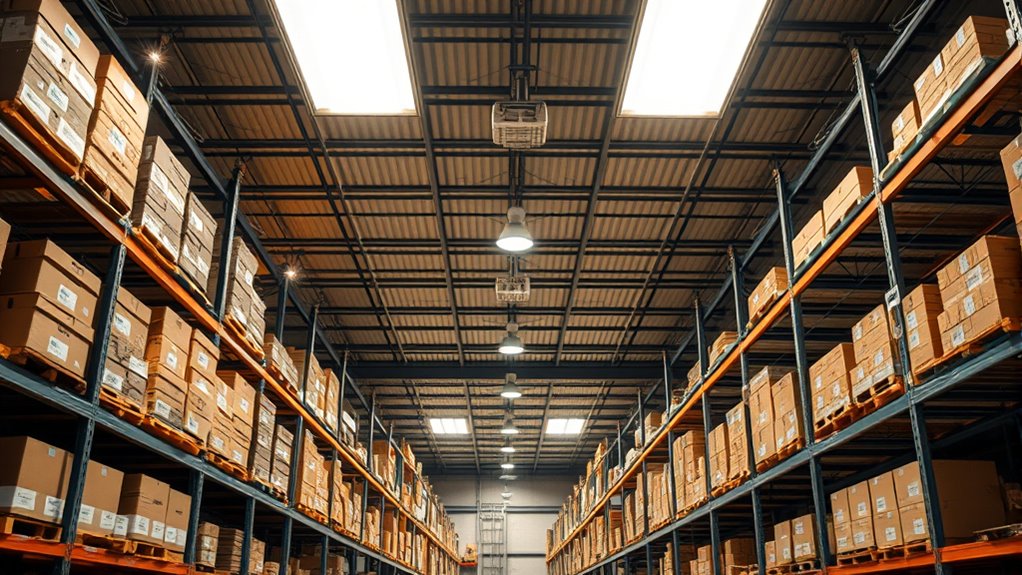
Emerging technologies are transforming warehouse illumination by introducing smarter, more efficient solutions. LiFi-enabled LED systems now transmit data through light waves, boosting communication and security within your facility. Electric buses and VW ID. Buzz exemplify how innovative transportation solutions are advancing sustainability, inspiring similar technological progress in warehouse lighting. Self-charging solar LED high bays operate independently of the grid, cutting energy costs and enhancing sustainability. Next-generation LEDs reach efficiencies of 200 lumens per watt, delivering brighter illumination while consuming less power. Integration of lighting into racks, machinery, and inventory systems enables real-time tracking and automation, streamlining operations. Additionally, advanced control systems facilitate remote management and detailed analytics, improving overall efficiency. Incorporating AI-assisted adaptive lighting analyzes occupancy, ambient light, and activity patterns to self-adjust illumination levels, optimizing energy efficiency and worker comfort. The development of smart sensors further enhances adaptive lighting by providing real-time feedback on environmental conditions, making your lighting system even more responsive. These innovations collectively lead to smarter illumination systems that adapt to your warehouse’s needs, making your space safer, more sustainable, and easier to manage.
Benefits and Standards for Effective Warehouse Lighting

Meeting industry standards like EN 12464 and LEED guarantees your warehouse stays safe, efficient, and environmentally friendly. Upgrading to LED and smart systems can cut energy use by up to 80% while improving visibility.
Staying compliant with evolving certifications not only boosts safety but also keeps your operations cost-effective and sustainable.
Compliance and Certification Standards
Compliance with established standards like EN 12464, DGUV regulations, LEED, BREEAM, and ISO 50001 is essential for ensuring your warehouse lighting is safe, efficient, and environmentally friendly. These certification standards specify metrics such as illuminance levels, glare control, and energy performance, helping you optimize visibility while reducing risks. Adhering to these regulations guarantees regulatory approval, improves worker safety, and boosts your company’s sustainability profile. Regular audits and certifications ensure ongoing compliance with evolving lighting standards, supporting long-term operational excellence. Here’s a quick overview:
| Aspect | Key Focus | Benefits |
|---|---|---|
| Certification Standards | Conformance, regulatory approval | Safety, legal adherence |
| Illuminance Levels | Adequate brightness | Visibility, reduced accidents |
| Glare Control | Minimize harsh reflections | Worker comfort, safety |
| Energy Performance | Efficiency and sustainability | Cost savings, environmental impact |
Industry Trends and Upgrades
Industry trends show that upgrading warehouse lighting systems offers significant benefits, from reducing energy costs to boosting safety and efficiency. Countries worldwide are embracing advanced lighting technology, with many shifting to LED lighting solutions for better energy efficiency. Retrofit upgrades are common, helping warehouses meet evolving standards and improve performance.
Asia and Australia are leading the way with smart lighting systems connected to operational control, optimizing energy use and inventory management. In Europe, widespread upgrades have cut energy consumption by 20%, while American warehouses plan extensive retrofits to boost compliance and efficiency.
These upgrades aren’t just cost-effective—they enhance safety, productivity, and sustainability.
- Experience safer work environments that protect your team
- Feel confident knowing your warehouse meets global standards
- Save money with energy-efficient LED lighting solutions
- Enjoy seamless operational control through smart lighting systems
- Stay ahead in a competitive industry with cutting-edge lighting technology
Frequently Asked Questions
What Is the Best Light for Poor Vision?
You want the best light for poor vision, so choose bright, high-CRI LED lighting in the 4000K to 5000K range. This type of light enhances contrast and color clarity, making everything easier to see.
Add focused task lighting to reduce glare and target specific areas.
Increase ambient light levels to at least 300-500 lux, and consider larger, high-contrast signage and adjustable fixtures to meet your specific needs effectively.
How Can You Improve the Lighting of the Artwork to Increase Visibility?
So, you want to make artwork pop? Start by swapping out dull, harsh lights for high CRI LED track or accent lights—they make colors look true and details sharp.
Use adjustable spotlights at 30-45 degrees to highlight features without glare, and ditch overhead fluorescents that wash out everything.
Dimming controls let you set the mood, ensuring every piece is seen in its best light.
What Is the 3 Lighting Rule?
The 3 lighting rule helps you create balanced, effective illumination by using three layers of light. First, you add ambient lighting to provide overall brightness.
Then, you include task lighting for specific activities like reading or working.
Lastly, you incorporate accent lighting to highlight features or decor.
How Can You Improve Lighting Conditions for People With Low Vision?
Improving lighting for low vision is like opening a window to clarity. You can do this by increasing ambient light to 400-1000 lux, using high-CRI LED bulbs to boost color contrast, and adding task lighting like adjustable reading lamps.
Avoid glare with matte finishes and anti-reflective coatings. Make sure your lighting is even, so no shadows hide important details, helping everyone see more clearly and comfortably.
Conclusion
By embracing these lighting solutions, you illuminate the path to safety, efficiency, and precision in your warehouse. Just as a lighthouse guides ships through darkness, the right lighting steers your operations toward success. When you prioritize clarity and adaptability, you create a beacon of productivity that withstands the test of time. In every illuminated corner, you foster confidence and excellence—transforming your warehouse into a sanctuary where visibility leads to victory.




